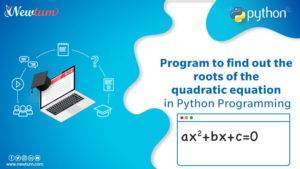In this tutorial, we will learn how to convert string to date time in Python. Specifically, we will focus on the process of converting a string to a datetime object using the strptime() function from the datetime module. We will explore the step-by-step logic and operation of the code and gain a deeper understanding of how this conversion takes place.
In the world of programming, handling dates and times is an essential task. Python, being a versatile and powerful language, offers various tools and functions to work with date and time data effectively. One common requirement is converting a string representation of a date and time into a datetime object, which allows for easier operation and analysis.
So, let’s understand the Python program to convert string to Date Time.
Python Program to Convert String to Date Time
# Python Program to Convert String to Datetime in python import datetime # Function to convert string to datetime def convert(date_time): format = '%b %d %Y %I:%M%p' # The format datetime_str = datetime.datetime.strptime(date_time, format) return datetime_str # Driver code date_time = 'Mar 1 2023 11:12AM' print(convert(date_time))
Code Explanation
Importing the Required Modules
First, we need to import the datetime module to access the functions and classes necessary for converting the string to a datetime object.
Defining the Conversion Function
Next, we define a function called convert() that takes a string representation of a date and time as input and converts it into a datetime object. Inside the convert() function, we define a variable called format which represents the expected format of the input string. In this case, the format is ‘%b %d %Y %I:%M%p‘, which corresponds to “Month Day Year Hour:MinuteAM/PM“. This format string must match the structure of the input string.
Converting the String to Datetime
Using the strptime() function from the datetime module, we convert the input string (date_time) into a datetime object. The strptime() function takes two arguments: the input string and the format string. It parses the input string according to the specified format and returns a datetime object.
Returning the Datetime Object
Finally, we return the datetime object from the convert() function using the return statement.
Calling the Conversion Function
After defining the convert() function, we can use it to convert the string to a datetime object. In this example, the input string is ‘Mar 1 2023 11:12AM’. We assign this string to a variable called date_time and pass it as an argument to the convert() function. The resulting datetime object is stored in a variable called datetime_str.
Displaying the Result
To verify the conversion, we print the datetime object by using the print() function. This will display the converted datetime object in the console.
Output:
The output of the code is a datetime object that represents the date and time contained in the input string in the specified format.
2023-03-01 11:12:00Let’s explore a couple of alternative methods:
Using the dateutil module:
The dateutil module provides a powerful parser that can handle a wide range of date and time formats. It offers the parse() function, which automatically detects the format of the input string and converts it to a datetime object. This method can be convenient when you have strings with varying formats. However, note that the dateutil module may not be included in the standard library, so you might need to install it separately.
Using the strptime() method directly:
Instead of defining a custom function, you can directly use the strptime() method of the datetime class. This approach is suitable for simpler cases where you don’t need to reuse the conversion code.
In our program code using a custom function, you can encapsulate the conversion logic, making it more readable and easier to maintain. It enhances code organization and can be reused across different parts of your program. You have control over the format string and can adjust it as per your specific requirements. This flexibility allows you to handle different date and time formats easily. The principle of modular programming separates the conversion functionality from the main program flow, promoting code reusability and easier testing.
Conclusion
This Python code demonstrates how to convert a string representation of a date and time into a datetime object using the strptime() function from the datetime module. By following the step-by-step guide provided, you can easily convert strings with specific date and time formats into datetime objects, enabling you to perform various operations on them.
Converting strings to datetimes is particularly useful when working with date-related data, such as in applications involving data analysis, time calculations, or data manipulation. By converting strings to datetimes, you can leverage the rich functionality of the datetime module to perform operations like date arithmetic, comparison, and formatting.
Frequently Asked Questions
Q: Why do we need to convert a string to a datetime object?
A: Often, we receive date and time information in the form of strings. Converting these strings to datetime objects enables us to manipulate and work with the dates and times more effectively, such as performing comparisons, calculations, or formatting for display purposes.
Q: What is the purpose of the strptime() function?
A: The strptime() function in Python’s datetime module is used to parse a string representation of a date and time according to a specified format and convert it into a datetime object.
Q: What happens if the input string does not match the specified format?
A: If the input string does not match the specified format, a ValueError will be raised. It is essential to ensure that the input string follows the format specified in the strptime() function.
Q: Can I use a different format for the input string?
A: Yes, you can use a different format for the input string depending on the structure of the date and time representation. Just make sure to update the format string in the convert() function accordingly.
Q: What if the input string contains an invalid date or time?
A: If the input string contains an invalid date or time, such as February 30th or an invalid time value, a ValueError will be raised. It is crucial to ensure that the input string represents a valid date and time.



